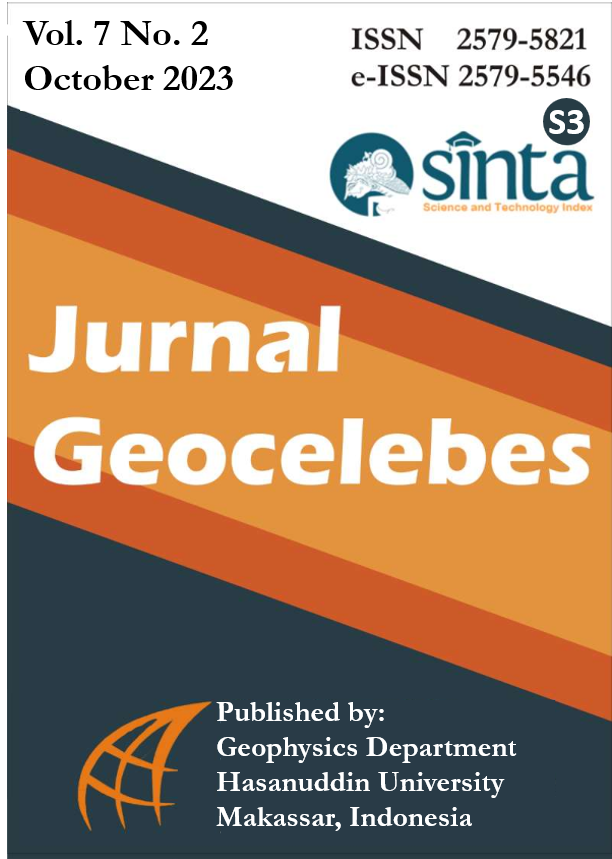Determination of Seawater Intrusion Zones Using the Resistivity Method in Kelurahan Soreang, Maros District, South Sulawesi Province
Penentuan Zona Intrusi Air Laut Menggunakan Metode Tahanan Jenis di Kelurahan Soreang, Kabupaten Maros
DOI:
https://doi.org/10.20956/geocelebes.v7i2.23710Keywords:
resistivity, seawater intrusion, Soreang, Wenner-SchlumbergerAbstract
The seawater intrusion into the groundwater layer is one of the factors that can disrupt groundwater quality in Soreang Village, Maros Regency. This is a serious problem for the community in the area, so it is necessary to identify the seawater intrusion zone. Previous study using the resistivity method is in regional scale. In this study, two intersecting lines with a length of 470 meters each were acquired using the Wenner-Schlumberger array with a spacing of 10 meters to get local scale. Based on the resistivity value of the study area, there are three layers interpreted as a layer of fill (1 - 1000 Ωm), alluvium layer (1 - 6 Ωm) and limestone layer (≥ 7 Ωm). The seawater intrusion zone in the study area is in the alluvium layer with varying depths up to 40 meters subsurface. The results of this study can be a reference for the community or government in the search for fresh water.
References
Abd-Elaty, I., Abd-Elhamid, H.F., & Negm, A.M. (2018). Investigation of Saltwater Intrusion in Coastal Aquifers. In: Negm, A. (eds) Groundwater in the Nile Delta, 329–353. Springer, Cham. https://doi.org/10.1007/698_2017_190
Alfarrah, N., & Walraevens, K. (2018). Groundwater Overexploitation and Seawater Intrusion in Coastal Areas of Arid and Semi-Arid Regions. Water, 10(2), 143. https://doi.org/10.3390/w10020143
Ardaneswari, T.A., Yulianto, T., & Putranto. T.T. (2016). Analisis Intrusi Air Laut Meggunakan Data Resistivitas dan Geokimia Airtanah di Dataran Aluvial Kota Semarang. Youngster Physics Journal. 5(4), pp.335–350. https://ejournal3.undip.ac.id/index.php/bfd/article/view/14116
Arsyad, M., Ihsan, N., & Tiwow, V. A. (2020). Analysis of mineral sediment characteristics of Bantimurung Bulusaraung National Park in the Karst Maros Region. Journal of Physics: Conference Series, 1572(012007), 1–7. https://doi.org/10.1088/1742-6596/1572/1/012007
Baba, K., Bahi, L., Ouadif, L., & Cherradi, C. (2014). Application des méthodes d’analyses statistiques multivariées à la délimitation des anomalies de Sidi Chennane (Multivariate Statistical Analysis tool for the interpretation of geoelectrical data: application to Sterile Bodies in the Sidi Chennane phosphatic deposit (Morocco)). Journal of Materials and Environmental Science, 5(4), 1005–1012. https://www.jmaterenvironsci.com/Document/vol5/vol5_N4/124-JMES-631-2014-Baba.pdf
Costall, A. R., Harris, B. D., Teo, B. Schaa, R., Wagner, F. M., & Pigois, J. P. (2020). Groundwater Throughflow and Seawater Intrusion in High Quality Coastal Aquifers. Scientific Reports, 10, 9866. https://doi.org/10.1038/s41598-020-66516-6
Diah, H., Adji, T. N., & Haryono, E. (2021). Perbedaan Tingkat Perkembangan Karst Daerah Peralihan antara Basin Wonosari dan Karst Gunungsewu. Media Komunikasi Geografi, 22(1), 51–61. https://doi.org/10.23887/mkg.v22i1.30885
Guo, Q., Huang, J., Zhou, Z., & Wang, J. (2019). Experiment and Numerical Simulation of Seawater Intrusion under the Influences of Tidal Fluctuation and Groundwater Exploitation in Coastal Multilayered Aquifers. Flow, Transport, and Reactions in Coastal Aquifers, 2019, 2316271. https://doi.org/10.1155/2019/2316271
Haroon, A., Micallef, A., Jegen, M., Schwalenberg, K., Karstens, J., Berndt, C., Garcia, X., Kühn, M., Rizzo, E., Fusi, N. C., Ahaneku, C. V., Petronio, L., Faghih, Z., Weymer, B. A., De Biase, M., & Chidichimo, F. (2021). Electrical resistivity anomalies offshore a carbonate coastline: Evidence for freshened groundwater? Geophysical Research Letters, 48, e2020GL091909. https://doi.org/10.1029/2020GL091909
Hermawan, O. R. & Putra, D. P. E. (2016). The Effectiveness of Wenner-Schlumberger and Dipole-dipole Array of 2D Geoelectrical Survey to Detect the Occurring of Groundwater in the Gunung Kidul Karst Aquifer System, Yogyakarta, Indonesia. Journal of Applied Geology, 1(2), 71–81. https://core.ac.uk/download/291851623.pdf
Huq, H., & Easher, T. H. (2021). Coastal Water: Wisdom, Destruction, Conflicts and Contestation – A Case of Southwest Coastal Region of Bangladesh. IntechOpen. https://doi.org/10.5772/intechopen.95002
Jeuken, A., Termansen, M., Antonellini, M., Olsthoorn T., & van Beek, E. (2017). Climate Proof Fresh Water Supply in Coastal Areas and Deltas in Europe. Water Resource Management, 31, 583–586. https://doi.org/10.1007/s11269-016-1560-y
Masciopinto, C., Liso, I., Caputo, M., & De Carlo, L. (2017). An Integrated Approach Based on Numerical Modelling and Geophysical Survey to Map Groundwater Salinity in Fractured Coastal Aquifers. Water, 9(11), 875. https://doi.org/10.3390/w9110875
Motallebian, M., Ahmadi, H., Raoof, A., & Cartwright, N. (2019). An alternative approach to control saltwater intrusion in coastal aquifers using a freshwater surface recharge canal. Journal of Contaminant Hydrology, 222, 56–64. https://doi.org/10.1016/j.jconhyd.2019.02.007
Moore, W. S., & Joye, S. B. (2021). Saltwater Intrusion and Submarine Groundwater Discharge: Acceleration of Biogeochemical Reactions in Changing Coastal Aquifers. Frontiers Earth Science, 9, 600710. https://doi.org/10.3389/feart.2021.600710
Prusty, P., & Farooq, S. H. (2020). Seawater intrusion in the coastal aquifers of India - A review. HydroResearch, 3, 61–74. https://doi.org/10.1016/j.hydres.2020.06.001
Rahman, M. T. U., Rasheduzzaman M., Habib, M. A., Ahmed, A., Tareq, S. M., & Muniruzzaman, S. M. (2017). Assessment of fresh water security in coastal Bangladesh: An insight from salinity, community perception and adaptation. Ocean & Coastal Management, 137, 68–81. https://doi.org/10.1016/j.ocecoaman.2016.12.005
Rahmaniah., Wahyuni, A., Massinai, M. F. I., Mun'im, A., & Massinai, M. A. (2021). Resistivity Method for Characterising Subsurface Layers of Coastal Areas in South Sulawesi, Indonesia. Journal of Geoscience, Engineering, Environment, and Technology, 6(4), 217–225. https://doi.org/10.25299/jgeet.2021.6.4.6242
Riwayat, A. I., Nazri, M. A. A., & Abidin, M. H. Z. (2018). Application of Electrical Resistivity Method (ERM) in Groundwater Exploration. Journal of Physics: Conference Series, 995(012094), 1–9. https://doi.org/10.1088/1742-6596/995/1/012094
Sufiyanussuari, S. A., Tajudin, S. A., Azmi, M. I. S., Zahari, M. N. H., & Muztaza, N, M. (2021). Groundwater Pathway Mapping Using Electrical Resistivity Tomography (ERT) Method. Journal of Sustainable Underground Exploration, 1(1), 32–37. https://publisher.uthm.edu.my/ojs/index.php/j-sue/article/view/10164
Downloads
Published
How to Cite
Issue
Section
License
Authors who publish with this journal agree to the following terms:
- Authors retain copyright and grant the journal right of first publication with the work simultaneously licensed under a Creative Commons Attribution License that allows others to share the work with an acknowledgement of the work's authorship and initial publication in this journal.
- Authors are able to enter into separate, additional contractual arrangements for the non-exclusive distribution of the journal's published version of the work (e.g., post it to an institutional repository or publish it in a book), with an acknowledgement of its initial publication in this journal.
- Authors are permitted and encouraged to post their work online (e.g., in institutional repositories or on their website) prior to and during the submission process, as it can lead to productive exchanges, as well as earlier and greater citation of published work (See The Effect of Open Access).





